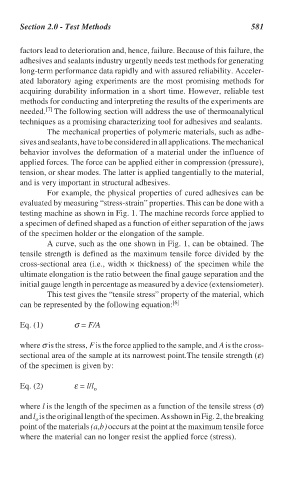Page 613 - Handbook of Thermal Analysis of Construction Materials
P. 613
Section 2.0 - Test Methods 581
factors lead to deterioration and, hence, failure. Because of this failure, the
adhesives and sealants industry urgently needs test methods for generating
long-term performance data rapidly and with assured reliability. Acceler-
ated laboratory aging experiments are the most promising methods for
acquiring durability information in a short time. However, reliable test
methods for conducting and interpreting the results of the experiments are
needed. [7] The following section will address the use of thermoanalytical
techniques as a promising characterizing tool for adhesives and sealants.
The mechanical properties of polymeric materials, such as adhe-
sives and sealants, have to be considered in all applications. The mechanical
behavior involves the deformation of a material under the influence of
applied forces. The force can be applied either in compression (pressure),
tension, or shear modes. The latter is applied tangentially to the material,
and is very important in structural adhesives.
For example, the physical properties of cured adhesives can be
evaluated by measuring “stress-strain” properties. This can be done with a
testing machine as shown in Fig. 1. The machine records force applied to
a specimen of defined shaped as a function of either separation of the jaws
of the specimen holder or the elongation of the sample.
A curve, such as the one shown in Fig. 1, can be obtained. The
tensile strength is defined as the maximum tensile force divided by the
cross-sectional area (i.e., width × thickness) of the specimen while the
ultimate elongation is the ratio between the final gauge separation and the
initial gauge length in percentage as measured by a device (extensiometer).
This test gives the “tensile stress” property of the material, which
can be represented by the following equation: [6]
Eq. (1) σ = F/A
where σ is the stress, F is the force applied to the sample, and A is the cross-
sectional area of the sample at its narrowest point.The tensile strength (ε)
of the specimen is given by:
Eq. (2) ε = l/l o
where l is the length of the specimen as a function of the tensile stress (σ)
and l is the original length of the specimen. As shown in Fig. 2, the breaking
o
point of the materials (a,b) occurs at the point at the maximum tensile force
where the material can no longer resist the applied force (stress).

